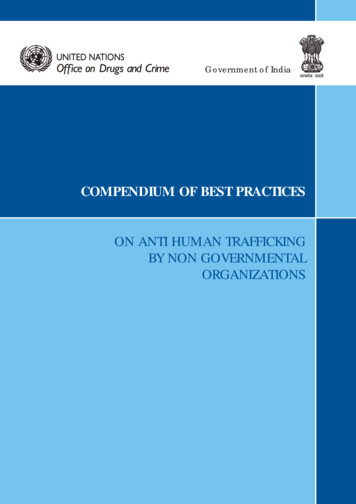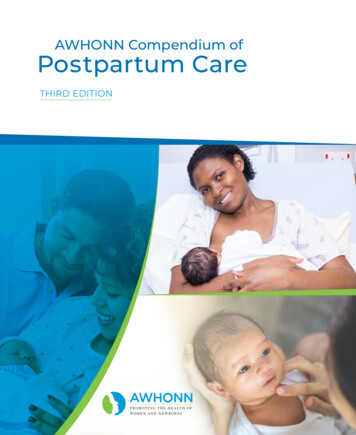
Transcription
Compendium ofbest practicesfor housing in AfricaBuild Solid GroundHABITAT FOR HUMANITYINTERNATIONAL, EUROPE,MIDDLE EAST AND AFRICAFebruary 2021Caroline Kroeker-Falconi andRachel Canclini Kettle, ACT-esEditor: Gyorgy Sumeghy
IndexIndexPromises and need forhousing in Africa3. Innovative housing financea. Context and recommendations from practiceb. Casesi. E nabling accessible housing microfinancesolutions for vulnerable communities bysupporting microfinance institutions andtheir ecosystem in Kenya and Uganda1. Introduction2. Housing and land:The global and African context3. Relevant commitments:SDG and Habitat III targets4. EU priorities and commitments5. African commitmentsii. I nnovation in home microfinance productsleads to women’s empowerment andimproved housing solutions in Kenyaiii. A ddressing land tenure security at multiplelevels in Zambia. SEE on p. 34Casesiv. MicroBuild Fund1. S ustainable and affordable housingconstruction and related value chains4. Land rights and security of tenurea. Context and recommendations from practiceb. Casesa. Context and recommendations from practiceb. Casesi. A ddressing land tenure security at multiplelevels in Zambiai. S ustainable brick technology supports safeand affordable housing provision in Malawiii. Expanding security of tenure in Côte d’Ivoireii. V ocational training equips young people forthe construction industry in Malawiiii. A dvocating for women’s property andinheritance rights in Lesothoiii. D elivering housing consumer educationvia SMS to achieve affordable and decenthousing in Kenya5. Slum upgradinga. Context and recommendations from practiceb. Casesiv. T echnology innovation improves low-incomehousing construction in Africai. S lum upgrading addresses rapidurbanization, housing and sanitation crisis inEthiopiav. A comprehensive community-led housingecosystem approach in Liberia. SEE on p. 452. Water and sanitationii. S caling up slum upgrading throughconsortiums and integrated strategies inKenyaa. Context and recommendations from practiceb. Casesiii. I nnovation in partnership leads to affordablehousing in Namibiai. I nnovative WASH programming supportsmarginalized groups and young people inCote d’Ivoireiv. A comprehensive community-led housingecosystem approach in Liberiaii. S chool-led total sanitation supports theyouth and the future of Malawiv. T he Participatory Slum UpgradingProgram (PSUP): Building multistakeholderpartnerships and ensuring communityparticipation in over 40 countriesiii. W ASH resilience project providessustainable water access for climateaffected communities in Ethiopiavi. W orking with government to change housingpolicy for informal settlements in SouthAfrica. SEE on p. 51iv. V illage Technology Education Centres (Vtec)provide WASH sustainability in Sierra Leonev. A comprehensive community-led housingecosystem approach in Liberia. SEE on p. 452
Index6. Policy and public partnerships:Comprehensive housing strategiesa. Context and recommendations from practiceb. Casesi. Working with government to changehousing policy for informal settlements inSouth Africaii. An integrated participatory program inKenya, The Participatory Slum UpgradingProgram (PSUP), A comprehensivecommunity-led housing ecosystemapproach in Liberia. SEE on p. 42 and 45iii. E xample of a global tool to support policyand public partnership initiatives:The Global Housing Policy Indicators’ portalConclusionsBibliography3
IntroductionIntroductionAbout Habitat for Humanity InternationalDriven by the vision that everyone needs a decent place to live, Habitatfor Humanity began in 1976 as a grassroots effort on a community farm insouthern Georgia. The Christian housing organization has since grown tobecome a leading global nonprofit working in local communities across all50 states in the U.S., and in more than 70 countries. Families and individualsin need of a hand up partner with Habitat for Humanity to build or improve aplace they can call home. Habitat homeowners help build their own homesalongside volunteers and pay an affordable mortgage. Through financialsupport, volunteering or adding a voice to support affordable housing,everyone can help families achieve the strength, stability and self-reliancethey need to build better lives for themselves. Through shelter, we empower.To learn more, visit habitat.org.Habitat for Humanity in AfricaHabitat for Humanity currently has programs and partnerships in Cote d’Ivoire,Ethiopia, Kenya, Lesotho, Liberia, Malawi, South Africa, Tanzania, Ugandaand ZambiaAbout the Build Solid GroundBuild Solid Ground is an awareness raising and citizenship engagementproject funded by the European Union grant under the Development Educationand Awareness Raising program. Over three years, 14 partners from sevenEU countries have worked as a consortium to inform and educate youngEuropean on global development issues.This publication was produced with the financial support of the European Union.Its contents are the sole responsibility of Habitat for Humanity and do notnecessarily reflect the views of the European Union.4
AcknowledgmentsAcknowledgmentsFinally, a special note of gratitude tothe editorial board:Their input was most helpful. They alsoprovided previously published andunpublished documents that served asthe basis for this compendium.We wish to extend our thanks to the authors, CarolineKroeker-Falconi and Rachel Canclini Kettle from ACT-es.Caroline conducted the interviews, desk research, topicalanalysis and editing, and Rachel drafted the cases.The organisations whose best practices featured inthis compendium were very generous with their timeand documents. We wish to thank especially the officesof Habitat for Humanity, Cities Alliances, Slum DwellersInternational and UN-HABITAT, along with their manypartners, for their collaboration in this manual and inthe pursuit of adequate affordable housing. A veryspecial thanks is extended to all who contributedthrough interviews and sharing their internal documents.Their insights, knowledge and lessons were invaluable.Editorial board contributors:Katerina Bezgachina, Dina Hashem,Anne Myers, Amanda EntrikinCopy editor:Adam SmithDesign:Sarah LongInterview contributorsJane OtimaHabitat for Humanity International/Terwilliger Center for Innovation in Shelter, in NairobiAssociate Director, Market Systemsand EntrepreneurshipJohn AkudagoHabitat for Humanity International/Global ProgramsDirector, International Shelter InitiativesSoida BarasaHabitat for Humanity International/Terwilliger Center, NairobiResilient Housing Technology SpecialistGeorge MugweruHabitat for Humanity Kenya andHabitat for Humanity International/Terwilliger CenterHousing Microfinance and Housing SupportServices Manager, Kenya, and Consultant for theTerwilliger CenterTamzin HudsonFormer Habitat for HumanityFormer Advocacy Manager for HFHI EMEAnow independent consultantSanjee SinghHabitat for Humanity International/Global ProgramsDirector, International Housing ProgramsGyorgy SumeghyHabitat for Humanity International/Europe, Middle East and AfricaAssociate Director, Policy and AdvocacyDereje AdugnaHabitat for Humanity EthiopiaNational DirectorMathabo MakutaHabitat for Humanity ZambiaNational DirectorJean Jacques YaoHabitat for Humanity Cote d’IvoireNational DirectorLucy MwaseHabitat for Humanity MalawiInterim DirectorMathew NdoteLiberia Country ProgramChief of PartyJulian BaskinCities AlliancePrincipal Urban AdviserChristophe LalandeUN-HABITATLeader of Housing UnitMark NapierCouncil for Scientific and Industrial Research,South Africa, (CSIR)Principal ResearcherSkye DobsonCities AllianceUrban SpecialistBeth Chitekwe BitiSlum Dwellers International (SDI)Managing Director of the SDI SecretariatJoe MuturiSDIChair of the SDI Management Committee5
Acronyms and abbreviationsAcronyms and abbreviationsACPAfrica, Caribbean and Pacific Group of StatesMHMMenstrual hygiene managementADHAktion Deutschland Hilft e.V.NDHSNational Department of Human SettlementsAIDSAcquired immunodeficiency syndromeNGONongovernmental organisationAUAfrican UnionNLTPNational Land Titling ProgrammeBMZFederal Ministry for Economic Cooperationand Development (Germany)NUANew Urban AgendaCBOCommunity-based organisationNUSPNational Upgrading Support ProgramCEOChief executive officerOVCOrphans and vulnerable childrenCJBLConstructing Jobs, Building Lives ProjectPASSAParticipatory Appraisal for Self-ShelterSettlement AwarenessCOVID-19Coronavirus disease 2019PPPPPeople, public and private partnershipsCSOCivil society organisationPSUPParticipatory Slum Upgrade ProgrammeCSPCities Support Programme (CSP)SDGSustainable Development GoalsDFIDDepartment for International Development (U.K.)SDISlum Dwellers InternationalDR3Disaster Risk Reduction and ResponseSLTSSchool-age total sanitationDRRDisaster Risk ReductionSMESmall and medium enterpriseDURABRICStabilised block in compressed earth with soil,sand, cement and waterSMSShort Message ServiceSPASpecial planning areaSSBStabilised soil bricksTCISHabitat for Humanity’s Terwilliger Centrefor Innovation in ShelterTEVETTechnical entrepreneurial and vocationaleducation and trainingTU DublinTechnical University DublinUISPUpgrading Informal Settlements ProgrammeUKUnited KingdomuKESAUrban Knowledge Exchange Southern AfricaUNUnited NationsUN-HABITATUnited Nations Human Settlements ProgrammeUNDPUnited Nations Development ProgrammeUNHLPFU.N. High-Level Political ForumUNICEFUnited Nations International Children’sEmergency FundEUEuropean UnionEWBEngineers Without BordersFinTechFinancial technologyGDPGross domestic productGHIGlobal Housing IndicatorsGPSGlobal Positioning SystemHFHHabitat for HumanityHFHCIHabitat for Humanity Côte d’IvoireHFHEHabitat for Humanity EthiopiaHFHIHabitat for Humanity InternationalHFHLHabitat for Humanity LesothoHFHMHabitat for Humanity MalawiHFHSAHabitat for Humanity South AfricaHFHZHabitat for Humanity ZambiaHICHousing and Infrastructure ConsortiumUSUnited StatesHIVHuman immunodeficiency virusVTCVocational training centresHLPFUN High-Level Political ForumVVillage Technology Education CentreHMFHousing microfinanceWASHWater, sanitation and hygieneIDPIntegrated development planWIEGOIFADInternational Fund for Agricultural DevelopmentIHDPIntegrated housing development programWSEWomen in Informal Employment: Globalizingand OrganizingWater, Sanitation, and Energy ConsortiumISSBInterlocking stabilised soil bricksYAHYoung Africa HubISSPInformal settlement support planZLAZambia Land AllianceKWFTKenya Women Finance TrustM&EMonitoring and evaluationMFIMicrofinance institutionsTEC6
Executive summaryExecutive summarySome of the main lessons are:This compendium was produced by the Build SolidGround1 project to document positive stories of changein the areas of adequate and affordable housing,including basic services, land tenure and slum upgrading.Throughout Africa, exciting initiatives are catalysingactors and solutions to reach impact. There are importantlessons to learn. With this Compendium of Best Practicesfor Housing in Africa, we invite others to join the efforts ofthese initiatives.The priorities, interventions and policy recommendationspresented in this compendium are aligned with theglobal commitments of the 2030 Agenda for SustainableDevelopment and its Sustainable Development Goals,or SDGs, along with the New Urban Agenda, or NUA,and with the recent commitments and priorities ofthe European Union and Africa and their partnershipagreements. Practical applications and implementation must takeinto account the whole ecosystem of housing, whichcovers the actors and factors that ensure physicalhousing access, including the effects of households,communities, housing markets and the sociopoliticalenvironment on production, building, input value chains,financing, supply, demand, barriers, quality and othermarket and behavioural factors. A wide range ofsolutions are required, on a continuum, with flexibility,to be fit for purpose in each context. Comprehensive,integrated approaches work best. The policy environment: Policy frameworks andspecific policies, regulations and public practices areneeded to ensure sustainable, lasting impact. Policywork is also important because of the influence ofthe public/government environment and the role ofauthorities as duty-bearers. This change requiresstrategic advocacy efforts. Implementation does notalways follow policy or public commitments. It is along-term and iterative process. Evidence-based strategies are most successful. Datacollection also enables buy-in, collaboration and moreeffective responses. Partnerships are key, at all levels and with all relevantstakeholders, including the families concerned,organised civil society organisations, experts,experienced NGOs, and the private and public sectorsat all levels (from community and municipal to national,from technical to political). Many cases illustrate thatpeople, public, private partnerships are critical forresults and for sustainability. Communities, familiesand community-based organisations must participatewith significant roles. A range of CSO and internationalorganisation actors help with capacity, financing,technical support and advocacy. Close collaborationsare most effective, including with the local, provincialand national authorities in their relevant ministries anddepartments.The compendium organises lessons learned into thefollowing chapters:1. T he components of housing construction, productionand improvement and related value chains.2. Water, sanitation and hygiene.3. Housing microfinance.4. Land tenure.5. Slum upgrading.6. P olicy and public partnerships and comprehensiveapproaches.It presents 19 best practice cases from innovativeexperiences in 11 African countries, covering flagshipprojects, contributions and collaborations from Habitat forHumanity, Cities Alliances, Slum Dwellers International,UN-HABITAT and their numerous local and internationalpartners. These stories clarify the context, actors, stepstaken, results, impact and lessons learned. They illustrateinnovations and cutting-edge practical applications whiledemonstrating effective practices that can be replicatedand scaled.1A Development Education and Awareness Raising in Europe project funded by the European Union.7
Promises and need for housing in AfricaPromises and need for housing in Africa1. Introductioneradication out of reach. The challenges are morecomplex and difficult in urban contexts. Rapid urbanizationis one of the most transformative trends in the 21stcentury — an astounding 54% of the global populationnow lives in cities.5This compendium was produced by the Build SolidGround project, which worked to inform EU citizensabout global housing, urban and land rights issues; toraise awareness; and to facilitate the active engagementof Europeans. The project has been implemented forthree years by a consortium of 14 nonprofit organizationsfrom seven EU countries, led by Habitat for HumanityInternational’s Europe, Middle East and Africa area office,with the support of the European Commission.Africa is a context marked by informality (70% live ininformal settlements and work in the informal sector),with a high proportion of young people and an extremelyhigh rate of urbanisation. Generally, basic servicesinfrastructure is lacking, of poor quality or not maintained.Governance is complex, local revenue and budgets arechallenged, and there has been little planning for urbanexpansion — which is true in most rapidly urbanisingcountries. Only in recent decades have housing, landand urban settlement ministries or public departmentsactively emerged and policies been considered or drafted.Nevertheless, local authorities, the public and privatesectors, civil society and professional actors are startingto work together to deliver solutions.From Build Solid Ground, a need emerged to documentpositive stories of change in these focus areas. AroundAfrica, exciting initiatives are offering evidence-basedmethods and catalysing actors and solutions to reachimpact in housing and land projects and policies. Theseadvances have strong repercussions on social change;the reduction of poverty; and the sustainable developmentoutcomes of families, their communities and theircountries. The challenges are deep and often growing, butit is possible to be part of effective social change. Withthis compendium of best practices, we invite others to jointhe efforts of the actors presented here.The right to adequate housing includes several coreelements: legal security of tenure, including protectionagainst forced evictions; availability of services (safedrinking water, adequate sanitation, energy for cookingand lighting, refuse disposal, waste management,recycling); affordability; access to housing finance;accessibility; habitability (providing physical safety,adequate space and protection from the elements);location (in relation to employment opportunities,health care, schools, childcare centres, resilience anddisaster risk reduction, transportation, and security); andcultural adequacy. As this is recognized in the commonunderstanding of the right — and in recent importantglobal agreements — all of these elements must beaddressed.6 This compendium presents cases relevant toall of these core elements and their interactions.2. Housing and land: The global andAfrican contextToday, as the world confronts increasing threats fromthe COVID-19 pandemic, social conflict, environmentaldegradation, economic inequality, rapid urbanization andhumanitarian crises, we are faced with an unprecedentedglobal housing challenge: 1.6 billion people in the world livewithout adequate shelter.2 Many live in fear of eviction, asthey lack some form of tenure documentation.3 Amongthem, 1 billion live in slums.4 These critical gaps shouldraise alarms. They have negative repercussions for thepoor and mean a loss of opportunities for development,particularly for women. Many find adequate housing,water, sanitation and land options unaffordable. Thesecosts hamper the respect of other human rights. This,in turn, worsens other aspects of life and keeps povertyIn addition, COVID-19 has brought to light the centralrole of a home for improving public health, preventing thespread of the virus, and enabling economic survival.2 The World Bank, May 2016. “Housing for All by 2030.” 05/13/housing-for-all-by-20303 Worldwide, 75% of land is not legally documented. Global Land Tool Network (GLTN) and UN Habitat, curity/4 UN-HABITAT, 2003. The Challenge of Slums: Global Report on Human Settlements, 2003. Earthscan Publications, London. See also Solid Ground and Habitatfor Humanity, 2016. Shelter Report: Level the field: Ending Gender inequality in Land Rights.5 United Nations, SDG11: Sustainable Cities and Communities — Make cities and human settlements inclusive, safe, resilient and 9/Goal-11/United Nations, Department of Economic and Social Affairs, Population Division, 2014. World Urbanisation Prospects: The 2014 Revision, Highlights. (ST/ESA/SER.A/352).6CESCR, 1991. General Comment N4. The Right to Adequate Housing.8
Promises and need for housing in Africa3. Global promises and vision:SDGs and the New Urban Agenda The positive ripple effects of housing and landAn adequate home can have transformational impacton individuals and communities because a home is asafe place to foster stability, security and opportunityfor its residents. Adequate homes affect people’s abilityto recover from shocks and thrive. Housing and itscomponents, including land tenure, are recognized andprioritized as central contributors to reducing poverty andcontributing to the sustainability of communities. Researchshows that safe, adequate and affordable housing leads tobenefits in health, education and economic opportunity.7Housing has a real impact on the economy: the housingconstruction sector alone contributes to about 7% of theGDP at the national level in Nigeria, to increasingly more inGhana, Kenya and Rwanda (nearly 9% of GDP in the later),up to 11% in Uganda and 14% in Tanzania.8 Access to landand tenure have been shown to a strong positive effecton levels of income and security9 and to enable homeimprovement, which is often a ladder out of poverty forfamilies.10 Through people-centered development, goodpolicies and system changes, there is a greater potentialto create well-being, stability and security for millions.The right of everyone to an adequate standard of living,including adequate housing, has been recognized fordecades.11 The United Nations’ definition of adequatehousing includes legal security of tenure and protectionagainst evictions; availability of services, material, facilitiesand infrastructure; affordability; habitability; accessibility;location; and cultural adequacy. Globally, the definition ofadequacy has been accepted and institutionalized throughvarious global declarations, conventions and plans ofaction.12Since 2015, the world has committed to a plan of actionfor ending poverty in all its dimensions and leaving no onebehind: the 2030 Agenda for Sustainable Developmentand its Sustainable Development Goals.13 States areresponsible for making progress toward the 17 uniquegoals and monitoring the 169 targets, the foundation forthe global agenda and reviews. National ownership andprogress are the keys to achieving the SDGs and leavingno one behind. Many other stakeholders also are essentialfor progress and must play a role, including public, privateand civil society organisations; foundations; multilateralorganizations; academia; the media; and individuals. Weare in a critical decade for all stakeholders to accelerateprogress toward achieving the SDGs by 2030.7 Landesa, 2015. “Why Land Rights Matter.” Infographic. er/Habitat for Humanity International, 2009. “Poverty Housing in the Developing Nations of the Pacific Ocean.” Page 6. https://www.habitat.org/sites/default/files/ap HFHAP Pacific Report.pdf.Landesa, “From the Ground Up.” d-up/Urban LandMark and Cities Alliance, 2013. Incrementally Securing Tenure: Promising Practices in Informal Settlement Upgrading in Southern Africa.Ziblim, A. & Sumeghy, G., 2013. The Dynamics of Informal Settlements Upgrading in South Africa. Research Report.8 Rust, K., March 2020. “Framing concept: Understanding the housing asset”. Centre for Affordable Housing Finance in Africa (CAHF). Blog. concept-understanding-the-housing-asset/See also: Rust, K. 15 September 2020, Risk, Resilience & Recovery. African Union for Housing Finance and CAHF. 29th Annual General Meeting. Power Pointpresentation. Based on: Gardner, D. & Lockwood, K. March 2019. Comparing Housing Economic Value Chains in Four African Countries. CAHF.9 Chen, C. 1961. Land Reform in Taiwan, p. 84, chart 12. See also F. Gershon and A. Nishio, 1999. “The Benefits of Land Registration and Titling: Economic andSocial Perspectives” Land Use Policy, Vol. 15, No. 1. Gershon and Nishio found a 200% increase in income.10 Deininger, K. 2003. Land Policies for Growth and Poverty Reduction. World Bank Policy Research Report p. 46; Washington, D.C.: World Bank and OxfordUniversity Press.Du Plessis, Jean; Augustinus, Clarissa; Barry, Michael; Lemmen, Christiaan; and Royston, Lauren, 2016. “The Continuum of Land Rights Approach to TenureSecurity: Consolidating Advances in Theory and Practice.” World Bank conference on land and poverty March 14, 2016. https://www.researchgate.net/publication/303697119 The continuum of land rights approach to tenure security consolidating advances in theory and practicePayne, Geoffrey; Durand Lasserve, Alain; and Rakodi, Carole, 2008. “Social and Economic Impacts of Land Titling Programmes in Urban and Peri-urban Areas:International Experience and Case Studies of Senegal and South Africa.” Final publication to Norway, Sida, GLTN and UN-HABITAT. March 44393 Social and economic impacts of land titling programmes in urban and peri-urban areasInternational experience and case studies of Senegal and South Africa11 International human rights law: Adequate housing was recognized as part of the right to an adequate standard of living in the 1948 Universal Declaration ofHuman Rights and in the 1966 International Covenant on Economic, Social and Cultural Rights. The Vancouver Declaration on Human Settlements (1976),Agenda 21 (1992), the Istanbul Declaration on Human Settlements (1996), the Habitat Agenda (1996 — the outcome of the Habitat II conference), and theMillennium Declaration and Millennium Development Goals (2000) also helped clarify various aspects of the right to adequate housing and reaffirmed states’commitments to its realization.12 Habitat for Humanity International, February 2020. Global Policy and Advocacy Agenda.13 United Nations, 2015. Transforming Our World. The 2030 Agenda for Sustainable Development. lopment%20web.pdf.9
Promises and need for housing in AfricaGovernments also committed to the right to adequatehousing in the 2030 Agenda and the SDGs.GOAL 1End poverty in all its forms everywhere:1. H ousing with all its elements, including land and slumupgrades, are critical14. SDG 11 is the most completegoal about housing and land, with clear targets.It acknowledges the importance of local governmentand communities in helping to achieve the SDGs. SDGs6, 1 and 5 in general — and in particular with specifictargets — will directly measure elements of “housing”and its broader related needs and challenges includedin the rights and definition of “adequacy.”Housing (in the broad sense), basic services andland tenure are symptoms of poverty and have directrepercussions on poverty levels and many other SDGs,such as income, health and education. In addition, globalcommitments are explicit:Target 1.4: By 2030, ensure that all men and women, inparticular the poor and the vulnerable, have equal rights toeconomic resources, as well as access to basic services,ownership and control over land and other forms ofproperty, inheritance, natural resources, appropriate newtechnology and financial services, including microfinance.2. I n addition, housing, basic services and land haveclear effects on the achievement of other SDGs.The way these other goals are implemented inturn affects housing, services, land tenure, povertyeradication and gender equality. As these links arenot always considered by donors but are critical tofuture EU priorities, the proposals and best practicesof this compendium illustrate these relationships withevidence and provide solutions that also advancethese “non-housing” SDGs.15 In the future, much moreattention will be placed on these links, as they arecritical for families, communities and the planet.Indicator 1.4.2: Proportion of total adult population withsecure tenure rights to land, with legally recognizeddocumentation and who perceive their rights to land assecure, by sex and by type of tenure.GOAL 5Achieve gender equality and empower all women and girls:A cross-cutting goal. Housing, basic services and landcause particular challenges and additional repercussionsfor women. There is also a specific link:Important “right to housing” SDGs16Target 5.a: Undertake reforms to give women equal rightsto economic resources, as well as access to ownershipand control over land and other forms of property,financial services, inheritance and natural resources, inaccordance with national law.GOAL 11Make cities and human settlements inclusive, safe,resilient and sustainable:Target 1: “Ensure access for all to adequate, safe andaffordable housing and basic services and upgradeslums.” See also nine other targets about cities thataddress housing-related changes and must be monitored.Indicator 5.a.2: Proportion of countries where the legalframework (including customary law) guarantees women’sequal rights to land ownership and/or control.Indicator 11.1.1: Urban population living in slums, informalsettlements or inadequate housing.Related SDGsSDG 8GOAL 6Decent work and economic growth.Ensure access to clean water and sanitation for allby 2030.Research has shown that housing and land tenure have adirect impact on home businesses and entrepreneurship,affecting household income and also national economies.In addition, the housing sector is an important andgrowing part of the economy. As housing is increased andimproved, this creates more jobs. Creating opportunitiesThree targets are relevant to households, and three moreaddress systems management and support. There areseven relevant indicators about water, sanitation andhygiene access and quality, also known as WASH.14 United Nations, Aug. 11, 2016. “Goal 11: Make Cities Inclusive, Safe, Resilient and Sustainable.” U.N. Sustainable Development Goals.www.un.org/sustainabledevelopment/cities/.15 Numerous additional global agreements that seek to achieve diverse impacts on living conditions around the world have been signed in recent years, includingthe SDGs and the NUA, the Paris Climate Accords, the Sendai Framework for Disaster Risk Reduction, and the Addis Ababa Action Agenda.16 https://sdgs.un.org/goals10
Promises and need for housing in Africato innovate housing solutions, technologies and materialswill further spur decent job creation and entrepreneurship,especially opportunities for young people and women.All the U.N. member states, having committed to theSDGs, have agreed to voluntarily review their progressannually and present it at the United Nations High-LevelPolitical Forum, or HLPF. At the HLPF of 2020, severalnational governments, including Kenya
Caroline conducted the interviews, desk research, topical analysis and editing, and Rachel drafted the cases. The organisations whose best practices featured in this compendium were very generous with their time and documents. We wish to thank especially the offices of Habitat for Humanity, Cities Alliances, Slum Dwellers










